Start Enable Relay Contact
Overview
This symptom-driven test is performed if the engine does not crank with the Driver Interface Device in neutral, the transmission confirming neutral, and there are no Active or Inactive fault codes.
Detection
- Engine does not crank with the transmission in neutral.
- Engine cranks with the transmission in a non-neutral position.
Possible Causes
- Vehicle Power and Ground
- Poor power or ground supply to TECU
- Battery failure
- Bent, spread, corroded or loose terminals
- Start Enable Relay
- Internal failure
- Start Enable Relay Circuit
- Bypassed or “jumped” Start Enable Relay circuit
- Bent, spread, corroded or loose terminals
- Wiring shorted to ground, shorted to power or open
Component Identification
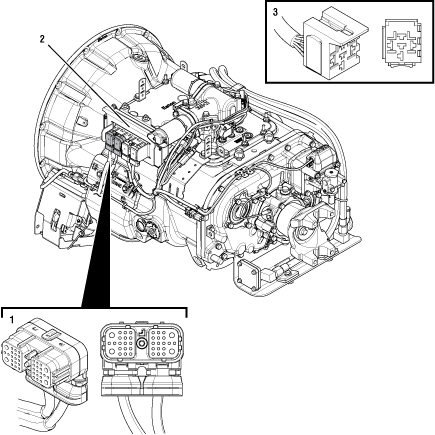 |
1. 38-Way Vehicle Harness Connector 2. Transmission Electronic Control Unit (TECU) 3. 5-Way Start Enable Relay Socket |
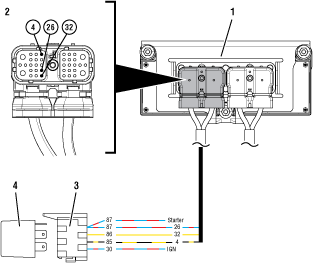 |
1. Transmission Electronic Control Unit (TECU) 2. 38-Way Vehicle Harness Connector 3. 5-Way Start Enable Relay Socket 4. 5-Way Start Enable Relay |
 |
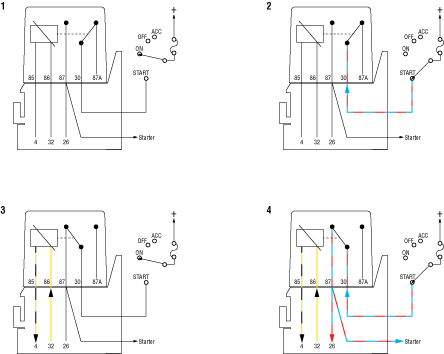 |
Start Enable Relay Circuit States (Normally Open) 1. Open Relay - Key On and Transmission is Unable to Confirm Neutral 2. Open Relay - Key Start and Transmission is Unable to Confirm Neutral 3. Closed Relay - Key On and Transmission Confirmed in Neutral 4. Closed Relay - Key Start and Transmission Confirmed in Neutral |
 |
Start Enable Relay Contact Test
Key off.
NoticeVerify that the Driver Interface Device is in the Neutral (N) position.
Key on with engine off.
Verify that the transmission confirms Neutral (“N”) in the gear display.
If the transmission confirms Neutral, Go to Step B
If the transmission will not find Neutral, troubleshoot per the Main Case Control Test Main Case Control.
Perform the Electrical Pretest. Reference the Electronic Clutch Actuator (ECA) Identification Overview. Record the reading(s) from the Load Test in Step C of the Electrical Pretest in the table.
If Electrical Pretest fails, repair per Electrical Pretest instructions and retest vehicle operation.
If Electrical Pretest passes, Go to Step C
| Battery | Voltage Drop | Load Test Status (Pass/Fail) |
|---|---|---|
| 1 | ||
| 2 | ||
| 3 | ||
| 4 | ||
| 5 |
Key on with engine off.
Set parking brake and chock wheels.
Connect ServiceRanger.
Create a Service Activity Report within ServiceRanger to retrieve Snapshot and VPA data.
Update transmission software to latest available level.
CautionRetrieve and record the transmission fault codes and FMIs, and their occurrences and timestamps.
Inspect the vehicle to determine if the Start Enable function is performed through a physically hard- wired relay or a transmission message broadcast over the J1939 Data Link.
If the Start Enable is performed by a message over the J1939 Data Link, Go to Step D
If a Start Enable Relay is directly hard-wired to the TECU, Go to Step G
Key off.
Note: Allow 2–3 minutes for the TECU to perform a complete power-down sequence before proceeding.
Key on with engine off.
Connect ServiceRanger.
Go To “Configuration”.
Select “Vehicle”.
Record the “Current Value” for the “Start Enable Type”.
Record the “Start Enable Type” installed on the vehicle.
Note: The vehicle's “Start Enable Type” (Relay or J1939), is determined by the OEM. Refer to the OEM regarding “Start Enable Type” installed on the vehicle.
Compare reading(s) in table.
If “Start Enable Type” is configured correctly, Go to Step E
If “Start Enable Type” is not configured correctly, select the correct configuration from the “New Value” drop down, select “Apply” and follow on screen prompt. Go to Step V
| Location | Start Enable Type |
|---|---|
| TECU (ServiceRanger) | |
| Vehicle |
Key on with engine off.
Set parking brake and chock wheels.
Verify that the Driver Interface Device is in the Neutral (“N”) position.
Verify that the transmission confirms Neutral (“N”) in the gear display.
Attempt to crank the engine.
If engine cranks, Go to Step F
If engine does not crank, refer to Contact Information and contact Eaton for further diagnostics.
Key on with engine off.
Set parking brake and chock wheels.
Place the Driver Interface Device in a non-Neutral position.
Attempt to crank the engine.
Return the Driver Interface Device to Neutral (“N”).
If the engine cranks, refer to Contact Information and contact Eaton for further diagnostics.
If the engine does not crank, no fault was found. Test Complete. If additional troubleshooting is required, contact the OEM for additional information about this system.
Key on with engine off.
Connect ServiceRanger.
In ServiceRanger, go to “Configuration”.
Record current configuration of “J1939 Start Enable”.
Confirm the configuration matches the vehicle start enable system.
If the current configuration is “No” (matches), Go to Step H
If the current configuration is “Yes” (no match), refer to Contact Information and contact Eaton for further diagnostics.
Key on with engine off.
Set parking brake and chock wheels.
Verify that the Driver Interface Device is in the Neutral (“N”) position.
Verify that the transmission confirms Neutral (“N”) in the gear display.
Attempt to crank the engine.
If the engine cranks, Go to Step I
If the engine does not crank, Go to Step M
Key on with engine off.
Set parking brake and chock wheels.
Place the Driver Interface Device in a non-Neutral position.
Attempt to crank the engine.
Return the Driver Interface Device to Neutral (“N”).
If the engine cranks, Go to Step J
If the engine does not crank, Go to Step K
Key off.
NoticeSet parking brake and chock wheels.
Remove the Start Enable Relay.
Key on with engine off.
Place the Driver Interface Device in a non-Neutral position.
Attempt to crank the engine.
Return the Driver Interface Device to Neutral (“N”).
If the engine cranks, repair the short to power in the Start Enable Relay wiring. Repair or replace wiring per OEM requirements. Go to Step V
If the engine does not crank, replace the Start Enable Relay. Go to Step V
Key off.
NoticeVerify that the Start Enable Relay is wired per the UltraShift PLUS requirements in the wiring schematic.
Key off.
Disconnect the Start Enable Relay from the socket.
Measure resistance between 38-Way Vehicle Harness Connector Pin 32 and Start Enable Relay Socket Pin 86. Record reading(s) in table.
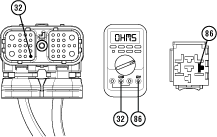
Measure resistance between 38-Way Vehicle Harness Connector Pin 4 and Start Enable Relay Socket Pin 85. Record reading(s) in table.
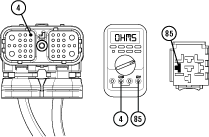
Measure resistance between 38-Way Vehicle Harness Connector Pin 26 and Start Enable Relay Socket Pin 87. Record reading(s) in table.
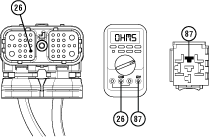
Compare reading(s) in table.
If all readings are in range, Go to Step L
If any reading is out of range, repair or replace Start Enable Relay wiring per OEM requirements. Go to Step V
| Pins | Range | Reading(s) |
|---|---|---|
| VH 32 to SER 86 | 0.0–0.3 ohms | |
| VH 4 to SER 85 | 0.0–0.3 ohms | |
| VH 26 to SER 87 | 0.0–0.3 ohms |
Set parking brake and chock wheels.
Place transmission in PD Mode. See more about Product Diagnostic (PD) Mode.
Note: Transmission does not enter PD Mode when there are Active fault codes.

Wiggle Start Enable Relay wiring from the 38-Way Vehicle Harness Connector to the Start Enable Relay. Look for signs of rubbing or chafing. Consult OEM for specific wire routing locations.
Exit PD Mode by powering down.
Notice
If any fault code sets Active during wiggle wire test, repair or replace the Start Enable Relay wiring per OEM requirements. Go to Step V
If no fault codes set Active, no problem was identified. Test complete. If additional troubleshooting is required, contact the OEM for additional information about this system.
Key off.
NoticeWarningRemove the Start Enable Relay.
Place a jumper wire between socket Pin 30 and Pin 87.

Key on with engine off.
Verify that the Driver Interface Device is in the Neutral (“N”) position.
Verify that the transmission confirms Neutral (“N”) in the gear display.
Attempt to crank the engine.
If the engine cranks, replace the Start Enable Relay. Go to Step N
If the engine does not crank, Go to Step O
Key off.
NoticeDisconnect 38-Way Vehicle Harness Connector from TECU.
Inspect 38-Way Connector body for damage and bent, spread, corroded or loose terminals.
Remove the Start Enable Relay.
Measure resistance between 38-Way Vehicle Harness Pin 26 and Start Enable Relay socket Pin 87.

If readings are in range, no problem was identified. Test Complete. Go to Step V
If any readings are out of range, repair or replace wiring per OEM requirements. Go to Step V
| Pins | Range | Reading(s) |
|---|---|---|
| VH 26 to SER 87 | 0.0–0.3 ohms |
Key off.
NoticeVerify that the Start Enable Relay is wired per the UltraShift PLUS requirements in the wiring schematic.
Note: If the Start Enable Relay is wired in a manner different than the wiring schematic, contact the OEM for further information.
Remove the Start Enable Relay from the socket.
Measure resistance between 38-Way Vehicle Harness Connector Pin 32 and Start Enable Relay Socket Pin 86. Record reading(s) in table.

Measure resistance between 38-Way Vehicle Harness Connector Pin 4 and Start Enable Relay Socket Pin 85. Record reading(s) in table.

Measure resistance between 38-Way Vehicle Harness Connector Pin 26 and Start Enable Relay Socket Pin 87. Record reading(s) in table.

Compare reading(s) in table.
If all readings are in range, diagnose wiring or Starter issue per OEM requirements. Go to Step V
If any readings are out of range, repair or replace wiring per OEM requirements. Go to Step V
| Pins | Range | Reading(s) |
|---|---|---|
| VH 32 to SER 86 | 0.0–0.3 ohms | |
| VH 4 to SER 85 | 0.0–0.3 ohms | |
| VH 26 to SER 87 | 0.0–0.3 ohms |
Key off.
Reconnect all connectors and verify that all components are properly installed.
Key on with engine off.
Clear fault codes using ServiceRanger.
Verify that the Driver Interface Device is in the Neutral (“N”) position.
Verify that the transmission confirms Neutral (“N”) in the gear display.
Test the Start Enable system by attempting to crank the Starter multiple times. Verify that the starting system operates properly.
Check for fault codes using ServiceRanger.
If no codes set and the engine cranks, test complete.
If the engine does not crank and a fault code sets, troubleshoot per Fault Code Isolation Procedure Index.
If the engine does not crank and no fault codes set, contact Eaton at (800) 826-4357.